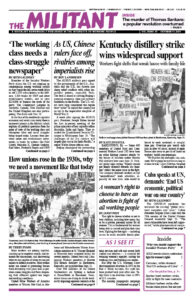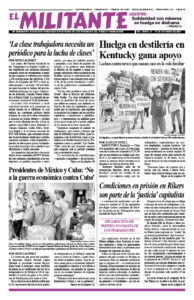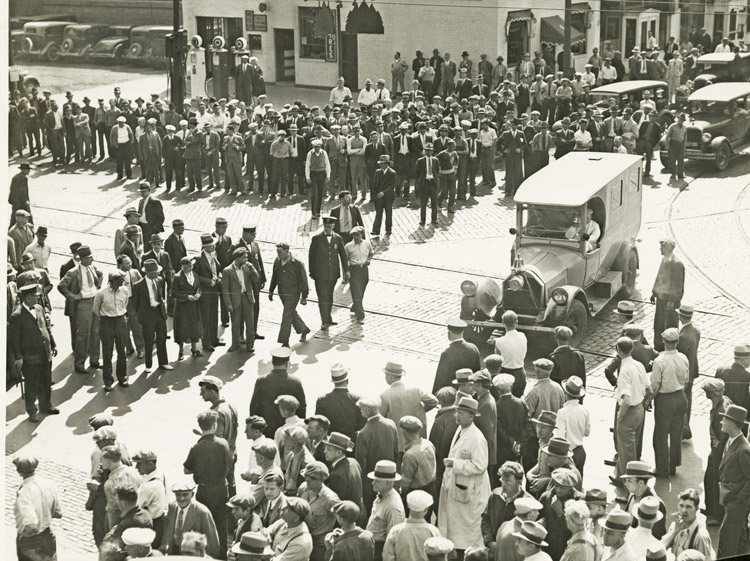More workers are joining together, standing up to employer attacks and demands for concessions, and discovering what we are capable of when we use our unions to defend ourselves. Most strikes today are aimed at preventing bosses from destroying vital gains won in previous union struggles and from deepening their offensive against our wages and working conditions.
United Mine Workers of America members at Warrior Met Coal in Alabama and Massachusetts Nurses Association members at St. Vincent Hospital in Worcester have sustained strikes for several months. United Food and Commercial Workers members at Heaven Hill Brands distillery in Bardstown, Kentucky, set up picket lines Sept. 11.
Over 650 members of the United Steelworkers are fighting a lockout at ExxonMobil in Beaumont, Texas, where bosses are trying to divide workers by imposing separate contracts at the two different parts of the refinery and impose changes making working conditions more dangerous.
Nearly 1,000 members of the Bakery, Confectionery, Tobacco Workers and Grain Millers union at five Nabisco facilities have just returned to work after making gains in a hard-fought five-week strike. Meatpackers in Quebec, members of the Union of Olymel Workers at Vallee-Jonction, ended their four-month strike Aug. 31 after beating back boss attacks. Unionists at both companies say they go back stronger and more united, ready to fight better to defend themselves on the job.
Workers all across North America point to the concessions squeezed from them in previous contracts to help “save the company,” only to find the bosses hungry for even more now. Many workers were told they were “essential” and pressed to work longer hours and faster during the pandemic. Now they find such conditions and worse are the “new normal.” Millions have been thrown out of work.
For decades most officials have weakened our unions by acting on the conviction that our interests depend on the bosses making profits and that our defense depends on reliance on the Democratic Party. The result is union membership in industry has declined to just over 6% today, from 35% in the 1960s.
Today’s crisis of capitalism pushes the bosses to step up efforts to defend their profits at our expense. In response, workers are looking to find ways to protect ourselves. Gallup polls show support for unions is higher than at any time since 1965. As workers use unions, or see others do so, we see our power to act as a class, and our determination and confidence grows. Any idea that workers have something in common with the bosses is undermined through class-struggle experience.
Powerful example of 1930s struggles
It took an explosion of bloody battles during the Depression of the 1930s for industrial workers to win union recognition and defend themselves. Militant action by hundreds of thousands, including a powerful wave of sit-down strikes 1936-37, organized auto, steel, packinghouses, oil and other basic industries.
Class-struggle militants and communist workers in Minneapolis led tens of thousands of trucking-industry workers in 1934 and after to organize a fighting Teamsters union movement. Their struggles show what workers are capable of when we have the leadership we deserve.
The general drivers union in Minneapolis united coal and food delivery truck drivers, warehouse workers and over-the-road drivers. In their strikes and organizing drives they reached out and won the backing of the unemployed, farmers, women and owner-operator truck drivers, establishing a strong union and providing leadership to the labor movement across 11 Midwestern states. They organized a union defense guard that defended their picket lines and blocked a fascist recruitment drive backed by the bosses that was aimed at attacking Jews and crushing the rising labor movement.
Teamster leaders acted on the fact that union democracy, discipline and unflinching solidarity with all those exploited and oppressed by capital was the only way to build a fighting union. They fought government frame-ups of union militants and organized labor opposition to the coming imperialist war.
Lessons learned during those struggles and the broadening political horizons of workers involved are described by Farrell Dobbs, a central leader of the union and of the Socialist Workers Party, in his four-volume Teamster series. Workers seeking to understand how to organize and harness union power today will find these books invaluable.
The Teamsters fight paved the way for broader battles that led to the rise of the Congress of Industrial Organizations.
A fighting social movement
A series of sit-down strikes begun by workers at General Motors and other auto plants beginning in 1936 spread to every kind of industry, involving high levels of organization, ingenuity and courageous and disciplined defense by the unionists who occupied the bosses’ factories. They were backed by family members and other workers who flocked to their side.
Bosses and governments from city halls to the White House responded with cops, injunctions and the National Guard, but determined workers and their allies held their ground and they won. The CIO, formed in 1935, helped advance these struggles.
It organized millions of workers that the old craft-union leaders had viewed as trash, and for the first time attracted into the labor movement large numbers of Black workers. By 1940 there were 200,000 Blacks in CIO unions.
As workers began to sense their class power in struggle against the bosses, many were attracted to organizing independently of the bosses’ political parties. Growing interest in establishing a labor party was frustrated by union officials and the Communist Party, who did everything in their power to prevent workers from breaking with reliance on President Franklin D. Roosevelt, who they touted as a “friend of labor.” Motion toward a labor party was derailed by the U.S. rulers’ entry into the second imperialist world war.
In the decades since, most union officials increasingly subordinated workers’ interests to collaboration with employers, rather than mobilizing the union ranks to rely on ourselves and our allies to fight for what we need. They doubled down on tying our unions to the two parties of the capitalist rulers.
The fact is, social relations under capitalism depend entirely upon the exploitation of workers by the ruling propertied families. Their dog-eat-dog drive for profit, and racist oppression and wars for markets, ensure workers will increasingly look for ways to combine together to defend ourselves.
The worsening impact of the economic, political and moral crisis of capitalism is creating a greater willingness to organize and use unions, to overcome divisions bosses promote to try to stop us from fighting back effectively. More workers are acting together and taking initiatives to build solidarity that is crucial to those walking picket lines.
And they are discussing why we need to break from the bosses’ Democratic and Republican parties and build our own political party, a labor party.


